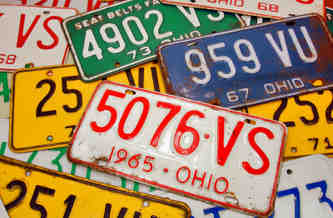
The earliest license plates on U.S. cars were made of wood, leather or even porcelain. By the time plates were standardized in size — 12 inches by 6 inches — almost all were made of steel. States later switched to aluminum, a more expensive material that is much cheaper to mail and doesn’t rust.
Today, many states have begun producing thermal-printed, flat plates on vinyl.
The primary purpose of license plates is to provide a unique identifier that connects every vehicle to a registered owner. They make enforcement of tolls, border crossing, parking regulations and other traffic laws possible, assist in identifying vehicles used in crimes or involved in hit-and-run accidents, and their reflective surface improves nighttime visibility.
Penalties for violating the two-plate law range from fix-it tickets to fines of up to $200 in Texas.
Assuming there is a valid registration for the vehicle, tickets for missing license plates generally do not go on the driver’s motor vehicle record as a moving violation and are thus unseen by auto insurance companies. They should not affect your car insurance rates.
But don’t ignore the ticket; it could lead to a suspended driver’s license for administrative reasons and send your rates through the roof.
States that require front license plates
- Alaska
- California
- Colorado
- Connecticut
- District of Columbia
- Hawaii
- Idaho
- Illinois
- Iowa
- Maine
- Maryland
- Massachusetts
- Minnesota
- Missouri
- Montana
- Nebraska
- Nevada*
- New Hampshire
- New Jersey
- New York
- North Dakota
- Ohio
- Oregon
- Rhode Island
- South Dakota
- Texas
- Utah
- Vermont
- Virginia
- Washington
- Wisconsin
- Wyoming
*Vehicles in Nevada that do not have a designated mounting position for a front plate are not required to use one.
In addition, these border provinces in Canada require two plates:
- British Columbia
- Manitoba
- New Brunswick
- Ontario
- Saskatchewan
These border states in Mexico require two plates:
- Baja California Norte
- Baja California Sur
- Chihuahua*
- Coahuila*
- Sonora*
- Tamaulipas*
*If the resident lives within 20 miles of the U.S. border
States that don’t require front plates
- Alabama
- Arizona
- Arkansas
- Delaware
- Florida
- Georgia
- Indiana
- Kansas
- Kentucky
- Louisiana
- Michigan
- Mississippi
- New Mexico
- North Carolina
- Oklahoma
- Pennsylvania
- South Carolina
- Tennessee
- West Virginia
— Michelle Megna contributed to this story.
Get advice from an experienced insurance professional. Our experts will help you navigate your insurance questions with clarity and confidence.
Browse all FAQs
